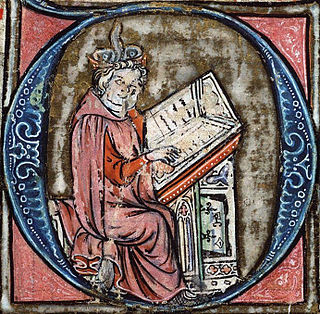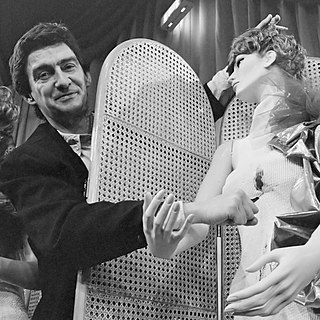
Voorne aan Zee is a municipality on the island of Voorne-Putten in the western Netherlands, in the province of South Holland. The municipality covers an area of 189.82 km2 (73.29 sq mi) of which 67.99 km2 (26.25 sq mi) is water. It had a population of 73,873 in 2022.

Jan van Beers was a Belgian poet born in Antwerp. He is usually referred to as "van Beers the elder" to distinguish him from his son, Jan van Beers (1852–1927), the painter.

Countess Eloise of Orange-Nassau, Jonkvrouwe van Amsberg, in the media often styled as simply Eloise van Oranje, is the first child and daughter of Prince Constantijn and Princess Laurentien of the Netherlands. She is the first grandchild of Queen Beatrix and Prince Claus of the Netherlands. She is a member of the Dutch royal family and currently fifth in the line of succession to the Dutch throne.

Jacob van Maerlant was a Flemish poet of the 13th century and one of the most important Middle Dutch authors during the Middle Ages.
Flemish literature is literature from Flanders, historically a region comprising parts of present-day Belgium, France and the Netherlands. Until the early 19th century, this literature was regarded as an integral part of Dutch literature. After Belgium became independent from the Netherlands in 1830, the term Flemish literature acquired a narrower meaning and refers to the Dutch-language literature produced in Belgium. It remains a part of Dutch-language literature.

De Rode Ridder is a Belgian Flemish comic book series set in medieval Europe. It stars the title character Johan, the Red Knight, easily recognizable by his red tunic. It appeared six days a week in the newspaper De Standaard and a few other ones.

De Jeugd Van Tegenwoordig is a Dutch hip hop and R&B group based in Amsterdam, Netherlands, renowned for their musical approach of irreverent, humorous lyrics and electronic beats. Their humorous style is characterized by their frequent use of word play, lyrical flirting with languages other than Dutch and the propagating of neologisms, such as "Watskeburt?!".

Tomas Ross is a Dutch writer who is famous for his historical criminal thrillers.
Het Jaar van de Kreeft is a 1975 Dutch film directed by Herbert Curiel.
Het Phoenix Mysterie is a 1990 Dutch drama film directed by Leonard Retel Helmrich.
Paula de Waart was a Dutch film actress of the silent era. She appeared in 24 films between 1915 and 1935.
The Bookspot Literatuurprijs is a prize for literature in the Netherlands and Belgium. It is awarded to authors writing in Dutch and amounts to €50,000. The ceremony is televised live each year. The prize was conceived in 1986 and inaugurated the following year with the aim to promote literature and increase the public's interest in books.

Hermine de Graaf was a Dutch novelist. De Graaf studied Dutch language and literature at the University of Amsterdam and worked as a teacher in Venray. Her debut as a writer was in 1984 with the publication of Een kaart, niet het gebied, a collection of ten short stories. In 1988 De Graaf won the Ferdinand Bordewijk Prijs for her novel De regels van het huis.

Maurice Heerdink is a Dutch painter known mostly for his subtle painted photo-realistic male nude art.
Daniël (Daan) van Golden was a Dutch artist, who has been active as a painter, photographer, collagist, installation artist, wall painter and graphic artist. He is known for his meticulous paintings of motives and details of everyday life and every day images.
Walter Schlee, born 15 December 1894 in Kępno, Posen province, Germany; died 5 February 1964 in Lugano, Switzerland, was a German screenwriter. The Jewish Schlee left German following the Nazi Party's takeover of 1933. He then worked in the Netherlands along with other exiles such as Max Ophuls.

Johan Wilhelm Henri van Wermeskerken was a Dutch playwright, novelist and journalist. He is considered the most prominent comedic playwright in the literature of the Dutch East Indies. His greatest successes were plays Tropenadel (1916) and Suikerfreule (1917), both of which he later adapted into novels. Despite criticism from literary figures such as Rob Nieuwenhuys and E. du Perron, Van Wermeskerken's short story collection Langs den gordel van smaragd (1923) was hailed as his masterpiece. His work was part of the literature event in the art competition at the 1928 Summer Olympics.

Willy Corsari was the stage name and pen name of Wilhelmina Angela Schmidt, a Dutch actor, author and composer. She is noted for her detective fiction and has been termed the Dutch Agatha Christie. Born in Jette, a municipality of Brussels, the daughter of a singer and a musician, she spent an itinerant childhood living in the Dutch East Indies, Germany and the Netherlands. Corsari developed as a writer at an early age, being first published at age ten. In 1914, she had her musical debut at the cabaret De Kattebel, performing on stage until 1932. At the same time, she developed her writing career. In 1927, she published her first three books, including Misdaad zonder Fouten. Many more followed. She also produced plays for the stage and radio, and, in 1972 an album of songs that she wrote and composed entitled Liedjes in de Schemer. During the Second World War, she gave a German deserter refuge and was consequentially imprisoned in Scheveningen, although released due to insufficient evidence. After the war, Corsari continued to publish and reached a peak in 1958 with over 200,000 copies of her omnibus sold in a year. She continued to write, producing Spelen met de dood in 1983, although by that time her output had reduced to very low levels. She was made a Knight of the Order of Orange-Nassau in 1990 and died in Amstelveen in 1998.










